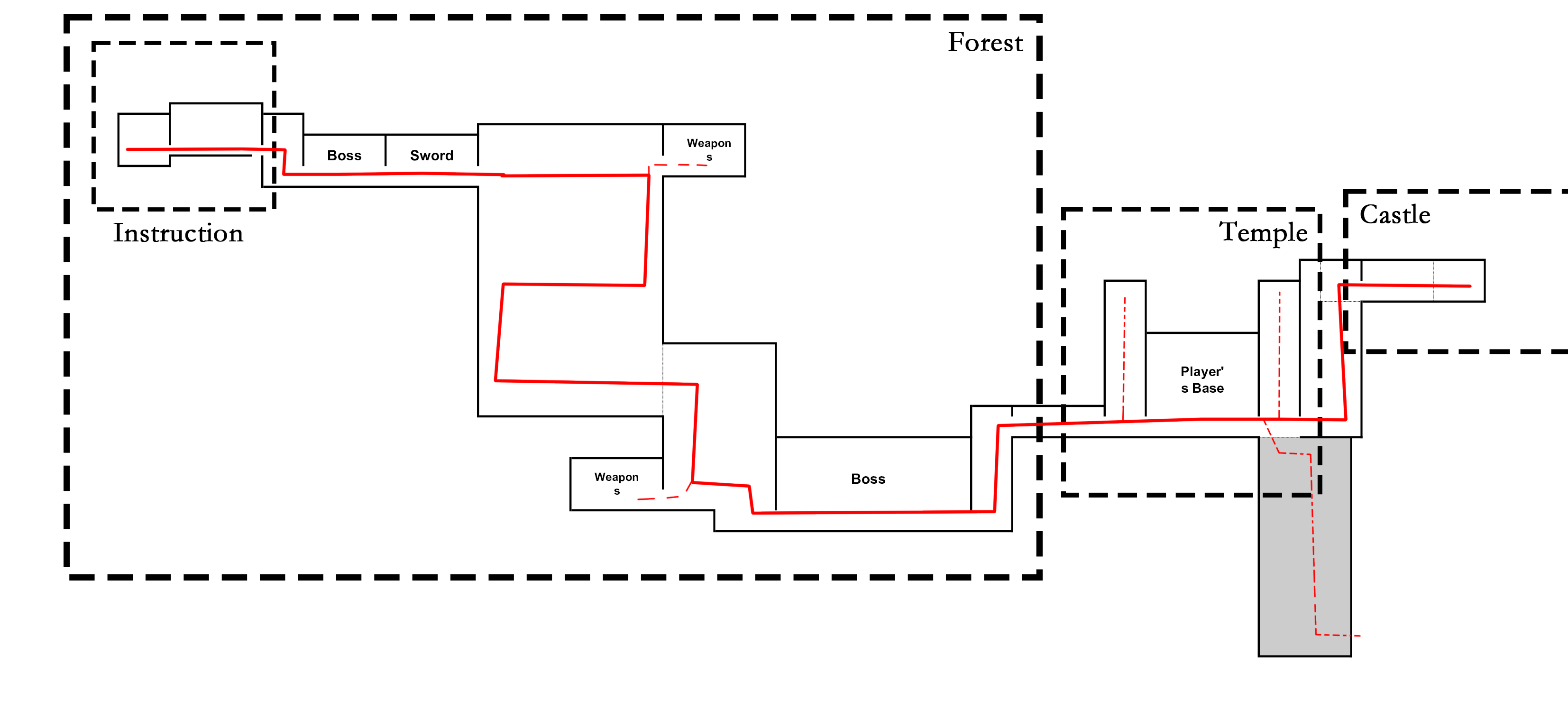Level Design Dev Log
Game Citation: Blasphemous, Hollow Knight, Ender Lilies
Walk through video (limited access only): https://drive.google.com/file/d/1dFtOisKS9DTyWYcD_AG76ApoWfBmuMzb/view?usp=share...
When designing the levels of Ascending Souls, we start with planning out the rough structure by hand or on spreadsheet. We then run a round of meeting to evaluate the quality of structure. One of the most important aspects we focus on the level structure is “reverse traverse ability”. Because Ascending Souls is going to be a Meteroid-vania game, it is important for levels to be able to experienced reversely: I see 2 possible routes, I took 1, after reaching its end I need to go back, can I manage that? To solve this problem, we paid extra attention to landscapes like big falls, high ladders and other situations that might disable the player from getting back, or the experience of traversing back is painful (like a super long ladder to climb). We also seek the solution from mechanics, to make sure some necessary cliffs are not breaking the exploration, we provide the player character ability to traverse. The climbing ladder mechanic that was briefly mentioned before is one of them. We found the wall jumping mechanic is not enough for traversing vertically, then we add an easier way to accomplish the same task.

After planning phase, the next step is to build the actual level. We usually start with grey box. If traversing the grey box feels ok, we quickly move on to building the level with visual elements – the tiles. Because Ascending Souls is a 2D game, testing with grey box only will not always provide enough information. So, the step of grey-boxing and tiling sometimes happen together – we need to feel the level with visual and atmosphere rendered. During this step, some environmental storytelling strategies were applied. Because of the limitation of visual art assets and narrative works (until now narrative is not at a high priority, the game remains more a pure ACT game rather than an ARPG game), environmental storytelling is limited to reveal information about the levels themselves. Take the ladder for example, we put a ladder hanging in the air to hint that on the top of it contains something. Actually, the ladder will lead you to a place that has weapons to collect. We do this trick repeatedly on hidden rooms to make sure that players get some hint and can explore the level easily.
When the landscape of the level is done, the final step would be putting the Enemies. Designing enemies are hard. We spent quite a lot of time (about a month) to develop the first standard melee enemy. This includes programming and designing mechanics. Luckily, we managed to develop a template that is easy to reuse for later enemy variants. Then the difficult problem comes to how should we design the other enemies. We struggled a lot trying to find a philosophy for accomplishing this job. Thanks to professor Blake Andrews who is teaching Level Design Studio at NYU Game Center, we decided that the enemies should be encouraging player to use their character abilities: how high they can jump; how the dodge roll work; should they attack aggressively…… Based on this rule, we managed to develop the game as it is right now. And this philosophy will be continued in the later development.
Our expectation for the levels in this demo is not only just providing challenge and game content, but the level should also do the job of introducing mechanics to players. Because narrative design is not among the first priority, the development around dialog, text displaying is not started until necessary. (The system is under active development right now.) So, we cannot count on an NPC to talk a huge chunk of words to tell the players how to play the game – we need to embed the soft introductions into the level. In the very beginning of the game, there is a Fake Boss – a melee enemy that only has a little bit more HP than others. On this boss, we put input instructions and explanatory text to let the player try (even without understanding that 100%) the weapon switching mechanic. Through playtesting, we found although some players still don’t get the mechanic 100%, they start to use and explore that aspect throughout the game. Which is already making a huge difference. We are very happy about the effect and are planning to make the process clearer by introducing more text related mechanics in the later development.
When developing the game, we sampled a lot of Meteroid-vania games to help us develop our own. We use Blasphemous as a great example to our level art design, and level structure design; we wanted to follow Hollow Knight’s way to introduce the action of attack although we gave up the idea shortly but used the essence of the idea to develop the soft introduction of weapon switch that is mentioned before; we experienced how Ender Lilies deal with air fighting, how many combos can be made, how powerful they are, etc. Learning from these previous games helped us lot on understanding what is good and what is bad.
Get Ascending Souls
Ascending Souls
| Status | In development |
| Authors | kksl_yw4146, ygu88, ruriw, Algedi, abandonsbox, jasmineLLR, yuy40wu, doudoujiang |
| Genre | Action, Adventure |
| Tags | 2D, Metroidvania, Pixel Art, Singleplayer |
| Languages | Chinese (Simplified) |
More posts
- Bug Fix v1.0.0 a1Apr 18, 2023
